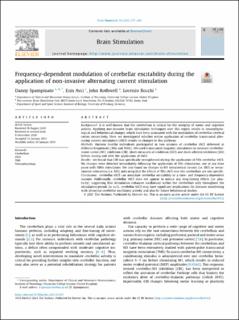| dc.contributor.author | Avci, Esin | |
| dc.contributor.author | Spampinato, Danny | |
| dc.contributor.author | Rothwell, John C. | |
| dc.contributor.author | Rocchi, Lorenzo | |
| dc.date.accessioned | 2021-04-23T08:16:05Z | |
| dc.date.available | 2021-04-23T08:16:05Z | |
| dc.date.created | 2021-04-22T13:01:23Z | |
| dc.date.issued | 2020 | |
| dc.identifier.citation | Brain Stimulation. 2021, 14 (2), 277-283. | en_US |
| dc.identifier.issn | 1935-861X | |
| dc.identifier.uri | https://hdl.handle.net/11250/2739272 | |
| dc.description.abstract | Background
it is well-known that the cerebellum is critical for the integrity of motor and cognitive actions. Applying non-invasive brain stimulation techniques over this region results in neurophysiological and behavioural changes, which have been associated with the modulation of cerebellar-cerebral cortex connectivity. Here, we investigated whether online application of cerebellar transcranial alternating current stimulation (tACS) results in changes to this pathway.
Methods
thirteen healthy individuals participated in two sessions of cerebellar tACS delivered at different frequencies (5Hz and 50Hz). We used transcranial magnetic stimulation to measure cerebellar-motor cortex (M1) inhibition (CBI), short-intracortical inhibition (SICI) and short-afferent inhibition (SAI) before, during and after the application of tACS.
Results
we found that CBI was specifically strengthened during the application of 5Hz cerebellar tACS. No changes were detected immediately following the application of 5Hz stimulation, nor at any time point with 50Hz stimulation. We also found no changes to M1 intracortical circuits (i.e. SICI) or sensorimotor interaction (i.e. SAI), indicating that the effects of 5Hz tACS over the cerebellum are site-specific.
Conclusions
cerebellar tACS can modulate cerebellar excitability in a time- and frequency-dependent manner. Additionally, cerebellar tACS does not appear to induce any long-lasting effects (i.e. plasticity), suggesting that stimulation enhances oscillations within the cerebellum only throughout the stimulation period. As such, cerebellar tACS may have significant implications for diseases manifesting with abnormal cerebellar oscillatory activity and also for future behavioural studies. | en_US |
| dc.language.iso | eng | en_US |
| dc.publisher | Elsevier Science | en_US |
| dc.rights | Navngivelse 4.0 Internasjonal | * |
| dc.rights.uri | http://creativecommons.org/licenses/by/4.0/deed.no | * |
| dc.title | Frequency-dependent modulation of cerebellar excitability during the application of non-invasive alternating current stimulation | en_US |
| dc.type | Peer reviewed | en_US |
| dc.type | Journal article | en_US |
| dc.description.version | publishedVersion | en_US |
| dc.source.pagenumber | 277-283 | en_US |
| dc.source.volume | 14 | en_US |
| dc.source.journal | Brain Stimulation | en_US |
| dc.source.issue | 2 | en_US |
| dc.identifier.doi | https://doi.org/10.1016/j.brs.2021.01.007 | |
| dc.identifier.cristin | 1905849 | |
| dc.description.localcode | This is an open access article distributed under the terms of the Creative Commons CC-BY license, which permits unrestricted use, distribution, and reproduction in any medium, provided the original work is properly cited. | en_US |
| cristin.ispublished | true | |
| cristin.fulltext | original | |
| cristin.qualitycode | 1 | |

